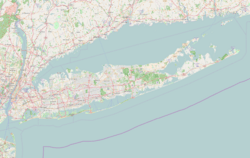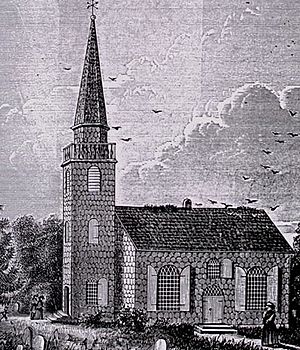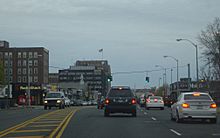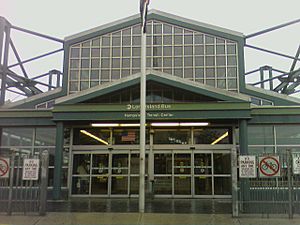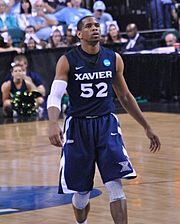Hempstead (village), New York facts for kids
Quick facts for kids
Hempstead
|
||
|---|---|---|
| Incorporated Village of Hempstead | ||
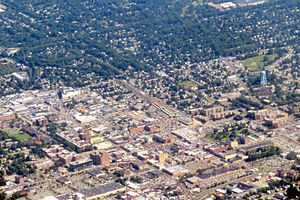
Hempstead in 2019, as seen from the air.
|
||
|
||

Location in Nassau County and the state of New York.
|
||
| Country | ||
| State | ||
| Region | Long Island | |
| County | Nassau | |
| Town | Hempstead | |
| Settled | 1643 | |
| Incorporated | 1853 | |
| Named for | Heemstede, Netherlands Hemel Hempstead, UK |
|
| Area | ||
| • Total | 3.70 sq mi (9.57 km2) | |
| • Land | 3.69 sq mi (9.56 km2) | |
| • Water | 0.01 sq mi (0.01 km2) | |
| Population
(2020)
|
||
| • Total | 59,169 | |
| • Density | 16,030.62/sq mi (6,189.90/km2) | |
| Time zone | UTC-5 (EST) | |
| • Summer (DST) | UTC-4 (EDT) | |
| Zip Code |
11550
|
|
| Area codes | 516, 363 | |
| FIPS code | 36-33139 | |
| GNIS feature ID | 0952574 | |
Hempstead is a lively village located on Long Island, New York. It's part of Nassau County and is the biggest village in New York state by population! In 2020, about 59,169 people called Hempstead home.
Hempstead Village is a very old place. It was the original "town spot" where English and Dutch settlers first built their community way back in the 1600s. This early settlement grew into the larger Town of Hempstead, the Town of North Hempstead, and eventually Nassau County. Today, Hempstead is the largest community in both the Town of Hempstead and Nassau County.
Part of Hofstra University is also located right here in Hempstead.
Contents
What's in a Name? The Meaning of Hempstead
Hempstead might have gotten its name from a town in England called Hemel Hempstead. This is where one of the village's founders, John Carman, was born.
Another idea is that the name comes from a town in the Netherlands called Heemstede. Many Dutch settlers who came to the area known as New Netherland were from there.
In 1664, the new settlement adopted a strict set of rules called the Duke's Laws. Because of these rules, Hempstead was sometimes called "Old Blue" due to its "blue laws," which were laws about what people could and couldn't do, especially on Sundays.
Hempstead's Story: A Look Back
How Hempstead Began
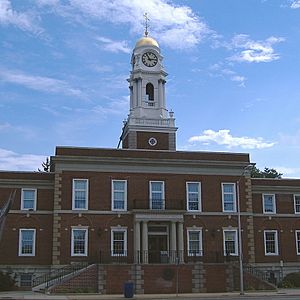
In the fall of 1643, two men, Robert Fordham and John Carman, rowed across Long Island Sound. They wanted to buy land from the local Native American tribes to start a new community. Representatives from the Marsapeague, Mericock, Matinecock, and Rekowake tribes met with them. Tackapousha, the chief of the Marsapeague, spoke for all the tribes.
The Native Americans sold about 64,000 acres of land. This land is now the towns of Hempstead and North Hempstead. They sold it for items that were very valuable to them at the time, even though they would be worth less than $100 today. This important event is shown in a painting inside Hempstead Village Hall.
In the spring of 1644, many families from Stamford, Connecticut, came to Long Island. They landed in Hempstead Harbor and then traveled to where Hempstead Village is now. They started the first English settlement in what is now Nassau County. More settlers arrived later and built a fort for protection.
These first settlers were Puritans. They were looking for a place where they could freely practice their religion. They started a Presbyterian church, which is the oldest one in the nation that has been active without stopping.
In 1843, a historian named Benjamin F. Thompson wrote about Hempstead. He said the village had 200 homes and 1,400 people. It was connected to New York City by a road and a railroad. He also noted that Hempstead had good soil, clean water, and fresh air. It was the main place for shopping and businesses in the county. Hempstead Village officially became an incorporated village on May 6, 1853. It was the first community in Queens County to do so (Nassau County didn't exist as a separate county until 1899).
Hempstead Grows and Becomes Important
Over the years, Hempstead grew in size and importance. In 1703, St. George's Church received a special silver communion set from Queen Anne of England.
Many important people, like George Washington, visited Hempstead. After he became President, George Washington toured Long Island and stayed overnight at Sammis Tavern in Hempstead.
Hempstead has also been home to famous people. Eleanor Roosevelt, the wife of President Franklin Delano Roosevelt, spent her summers here as a teenager. Peter Cooper, an inventor and politician, also lived here. He even ran for President!
Charles Lindbergh, the famous pilot who flew solo across the Atlantic Ocean, spent time in Hempstead before and after his flight from nearby Roosevelt Field. A writer named Christopher Morley loved Hempstead so much that he wrote an essay about it. His first novel, Parnassus on Wheels, was written in his Hempstead home in 1917. In 1704, the first stagecoach on Long Island made a stop here.
During the American Revolution, many people in Hempstead supported the British. They were called Tories. The British even used St. George's Church as a headquarters.
In 1898, a military camp called Camp Black was set up on the Hempstead Plains. This was to train soldiers for the Spanish–American War.
In the 1800s, Hempstead became a very important trading center for Long Island. In 1853, it became the first self-governing village. Wealthy families like the Vanderbilts and the Belmonts built homes here. Hempstead merchants delivered goods to farms and served as a hub for many businesses. Wagons full of goods would leave Hempstead and return later to restock. Bakeries and butchers also had routes from Hempstead to many other towns.
People from all over Queens came to Hempstead to buy things like stoves, which were hard to find elsewhere. For over two centuries, Hempstead was the main shopping center for Nassau County. Even today, many major roads in Nassau County start from Hempstead. It's truly the "Hub" of Nassau County. In the past, all stagecoaches traveling to eastern Long Island from Brooklyn passed through Hempstead. Today, many bus routes and train lines still connect Hempstead to other places.
Hempstead was the retail center of Nassau County from the 1940s to the 1960s. Big department stores like Arnold Constable and Abraham & Straus were located here. The Abraham & Straus in Hempstead was the most successful suburban department store in the country in the late 1960s. However, when large shopping malls like Roosevelt Field Mall opened nearby, and other changes happened, Hempstead's retail businesses faced challenges. Many stores, including Abraham & Straus, left the village in the 1980s and early 1990s.
Modern Hempstead
In the 1990s, Hempstead started to rebuild. It became a center for government offices and new businesses. Many government employees work in Hempstead, even more than in the county seat of Mineola. According to a historian, James York, the population during the day might increase to nearly 200,000 people from its usual 50,000.
New retail stores became interested in Hempstead again. This was thanks to efforts by former Mayor James Garner (1989-2005) and Glen Spiritis. For example, a large area that used to be Times Squares Stores is now Hempstead Village Commons, a big shopping center with stores like Pep Boys and Staples. The old Abraham & Straus department store was torn down and replaced with a new shopping area that includes Home Depot, Old Navy, and Stop & Shop.
With help from state, federal, and private money, old buildings were fixed up, and new affordable homes were built. The Long Island Rail Road Hempstead Terminal was updated in 2002. A new four-story building for senior housing with shops on the first floor was finished in 1998. Also, 32 affordable townhouses called Patterson Mews were completed in 1997.
In 1989, James A. Garner was elected as Hempstead's mayor. He was the first African-American mayor in New York state and served for four terms. In 2001, Lance Clarke became the first African-American male judge. Cynthia Diaz-Wilson was the first female justice in Hempstead and the first African-American village justice in New York state. Currently, Wayne Hall, a former village trustee, serves as mayor. He was elected in 2005.
Hempstead's Location
Hempstead Village covers about 3.7 square miles (9.5 km²) of land. It has a more urban feel, similar to nearby Queens County.
People of Hempstead
| Historical population | |||
|---|---|---|---|
| Census | Pop. | %± | |
| 1870 | 2,316 | — | |
| 1880 | 2,521 | 8.9% | |
| 1890 | 4,831 | 91.6% | |
| 1900 | 3,582 | −25.9% | |
| 1910 | 4,964 | 38.6% | |
| 1920 | 6,382 | 28.6% | |
| 1930 | 12,650 | 98.2% | |
| 1940 | 20,856 | 64.9% | |
| 1950 | 29,135 | 39.7% | |
| 1960 | 34,641 | 18.9% | |
| 1970 | 39,411 | 13.8% | |
| 1980 | 40,404 | 2.5% | |
| 1990 | 49,453 | 22.4% | |
| 2000 | 56,554 | 14.4% | |
| 2010 | 53,891 | −4.7% | |
| 2020 | 59,169 | 9.8% | |
| U.S. Decennial Census | |||
Population in 2020
| Race / Ethnicity (NH = Non-Hispanic) | Pop 2010 | Pop 2020 | % 2010 | % 2020 |
|---|---|---|---|---|
| White alone (NH) | 3,548 | 3,067 | 6.58% | 5.18% |
| Black or African American alone (NH) | 24,724 | 23,041 | 45.88% | 38.94% |
| Native American or Alaska Native alone (NH) | 96 | 147 | 0.18% | 0.25% |
| Asian alone (NH) | 704 | 1,242 | 1.31% | 2.10% |
| Pacific Islander alone (NH) | 13 | 17 | 0.02% | 0.03% |
| Some Other Race alone (NH) | 221 | 621 | 0.41% | 1.05% |
| Mixed Race or Multi-Racial (NH) | 762 | 1,394 | 1.41% | 2.36% |
| Hispanic or Latino (any race) | 23,823 | 29,640 | 44.21% | 50.09% |
| Total | 53,891 | 59,169 | 100.00% | 100.00% |
According to the 2020 census, Hempstead had a population of 59,169 people. The village is very diverse. About half of the population (50.09%) identified as Hispanic or Latino. The next largest group was Black or African American people, making up 38.94% of the population.
Population in 2010
In 2010, there were 53,891 people living in Hempstead. There were about 15,234 households and 10,945 families. Many households (38.7%) had children under 18 living with them.
The average household size was 3.41 people, and the average family size was 3.76 people. The median age in the village was 29 years old. This means half the people were younger than 29, and half were older.
The median income for a household was $45,234. This is the middle income level for all households. About 17.7% of the population lived below the poverty line.
Learning in Hempstead: Schools and Universities

Schools for Kids and Teens
Students in Hempstead attend schools within the Hempstead Union Free School District. For middle school, they go to Alverta B. Gray-Schultz Middle School. For high school, they attend Hempstead High School.
There is also a private high school in Hempstead called Sacred Heart Academy. It is a Catholic school for girls. Additionally, two charter schools, Academy Charter School and Evergreen Charter School, are located in the village.
Higher Education Opportunities
Hofstra University has a campus that is partly in Hempstead Village. The rest of the campus is in a nearby area called Uniondale.
Getting Around: Transportation in Hempstead

The Rosa Parks Hempstead Transit Center is one of the biggest transportation hubs in Nassau County. It's the final stop for the Long Island Rail Road's Hempstead Branch train line. Many Nassau Inter-County Express (NICE) bus routes also start or end here.
| Bus route
number |
Runs to / from | Notes |
| n6 |
|
|
|---|---|---|
| n6X | Express Service. | |
| n15 |
|
|
| n27 |
|
|
| n16 |
|
|
| n16X |
|
|
| n31 |
|
Via. West Broadway. |
| n31x |
|
Via Peninsula Blvd |
| n32 |
|
Via. Central Avenue. |
| n35 | ||
| n40 | Via. North Main Street. | |
| n41 |
|
Via. North Main St |
| n48 |
|
Via. Carmans Road. |
| n49 |
|
Via. Newbridge Road. |
| n54 |
|
Via. Jerusalem Ave / Washington Ave. |
| n55 |
|
Via. Jerusalem Ave / Broadway. |
| n70 |
|
|
| n88x (summer weekends only) |
|
Fun Places to Visit in Hempstead
- Hofstra University
- Hofstra University Arboretum (a garden with many different trees and plants)
- Hempstead Bus Terminal (a busy place for buses and trains)
- Nassau County African American Museum (learn about African American history and culture)
- St. George's Episcopal Church (a historic church)
- Christ's First Presbyterian Church – the first Presbyterian church ever started in the United States!
Famous People from Hempstead
Many interesting people have lived in Hempstead! Here are a few:
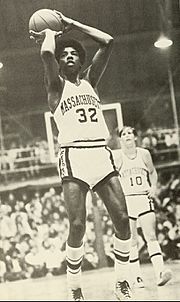
- Samuel L. Mitchill (1764–1831), a doctor, scientist, and politician. He was born in Hempstead.
- Walt Whitman (1819–1892), a famous American poet. He lived in Hempstead for a few years.
- William S. Hofstra (1861–1932), a successful businessman.
- Christopher Morley (1890–1957), a writer who lived in Hempstead in the 1910s.
- Frank Field (1923–2023), a TV weather forecaster.
- Joe Tex (1935–1982), a popular singer.
- Walter Hudson (1944–1991), known for holding a Guinness World Record for the largest waist. He lived in Hempstead his whole life.
- Julius Erving (born 1950), a basketball superstar, lived in Hempstead as a child.
- Sheryl Lee Ralph (born 1956), an actress and singer.
- Eric "Vietnam" Sadler (born 1960), a music producer for famous artists like Public Enemy and Ice Cube.
- Rob Moore (born 1968), an NFL football player.
- Method Man (born 1971), a well-known rapper and actor. He spent his childhood in Hempstead and Staten Island.
- Trevor Tahim "Busta Rhymes" Smith, Jr. (born 1972), a famous rapper, producer, and actor.
- Prodigy (1974–2017), a member of the hip-hop group Mobb Deep.
- Craig "Speedy" Claxton (born 1978), an NBA basketball player.
- Tavorris Bell (born 1978), a player for the Harlem Globetrotters.
- Roc Marciano (born 1978), a rapper and producer.
- Scott Lipsky (born 1981), a tennis player.
- A+ (born 1982), a rapper who made albums when he was in school.
- Tu Holloway (born 1989), a basketball player who plays for Maccabi Rishon LeZion in Israel.
See also
 In Spanish: Hempstead (condado de Nassau, Nueva York) para niños
In Spanish: Hempstead (condado de Nassau, Nueva York) para niños



